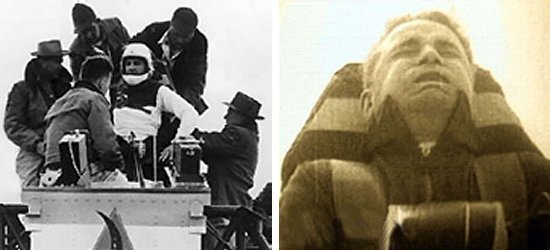
As with last week's badass scientist of the week, this week's scientist is both a thinker, and a human guinea pig. I present to you, John Paul Stapp - Colonel with the USAF, and fastest man on earth.
Dr Stapp was born in Bahia, Brazil, and joined the USAF just around the end of WWII. He was posted to the Aero Medical Laboratory, where he was placed in a team looking at oxygen delivery at high altitudes, as well as the prevention of the bends as the pilot changes pressures frequently. That work lead to a number of currently used techniques.
He was then moved to the deceleration project in 1947 - where he was looking at deceleration from high speeds using the 'gee whizz' rocket (4-kN acceleration) propelled simulator. One of the earlier innovations to come from this set-up was the safety of having rear-facing seats, which are installed in all USAF transport aircraft.
The wider scientific community believed the human body could not survive more than 18 Gs of deceleration--Stapp hit 35. In 1954 he decelerated from 120 miles per hour to 0 in a little under one-and-a-half seconds, and received two huge black eyes as a payoff. Apparently, he was blinded for two days as an added bonus. By some accounts, and he also broke his back, arm, wrist, lost six fillings and the icing on the cake? He got a hernia, and apparently had his retinas pop off more than once.
In return for these injuries, he then built a bigger rocket, believing that the limits of human deceleration had not been fully tested (what did he think was going to happen at the end of those limits?!), and eventually reached a peak G-force of about 42.6 Gs.
He pioneered work in Murphy's law (named after Major Edward Murphy, an Engineer on the team). He also flew about in a jet aircraft (at 917 Kph) without a canopy to establish that the wind effects at those speeds would not harm a person. Fortunately, he was right on that one.

 Podcast
Podcast




0 comments:
Post a Comment